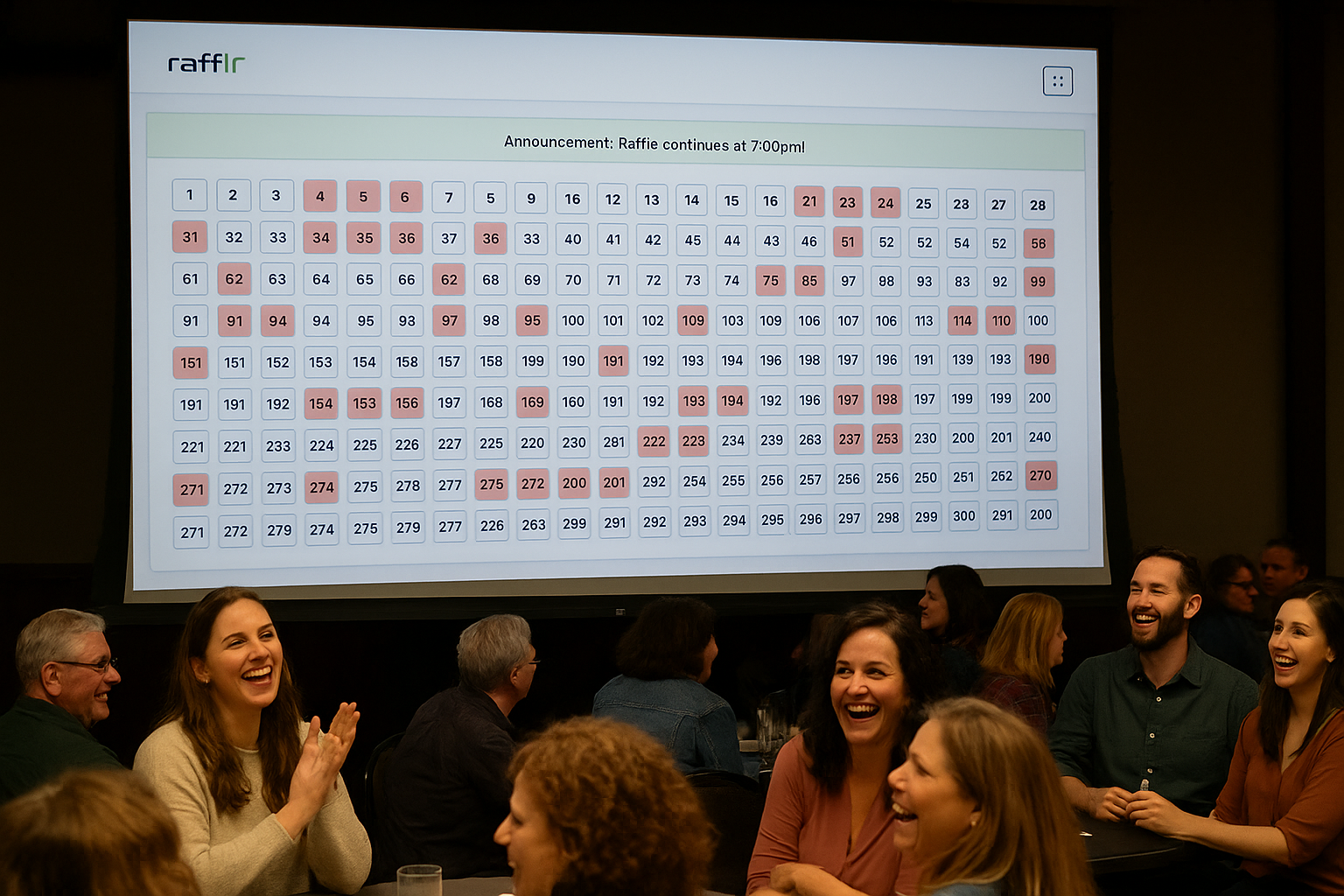Understanding your return on investment (ROI) is crucial for successful fundraising. Whether you're planning a charity auction, school fundraiser, or nonprofit event, calculating your raffle ROI helps you maximize profits, optimize ticket pricing, and ensure every dollar works harder for your cause.

What is Raffle ROI and Why It Matters
Raffle ROI (Return on Investment) measures the profitability of your fundraising event by comparing your net profit to your total costs. A higher ROI means you're generating more funds for your cause with less investment, making your fundraising efforts more efficient and impactful.
The basic ROI formula is simple:
Basic ROI Formula
Where Net Profit = Total Revenue - Total Costs
Why ROI Calculations Transform Your Fundraising
Smart nonprofit leaders use ROI calculations to:
- Optimize ticket pricing - Find the sweet spot between affordability and profit
- Compare fundraising methods - Determine if raffles outperform other events
- Budget effectively - Allocate resources to maximize returns
- Demonstrate success - Show board members and stakeholders concrete results
- Plan future events - Use data to improve upcoming fundraisers
See Professional Raffle Management in Action
Watch a 2-minute demo of how rafflr's professional features help maximize your fundraising ROI
Interactive Raffle ROI Calculator
Use this calculator to determine your raffle's ROI and identify optimization opportunities:
Calculate Your Raffle ROI
Understanding Your ROI Results
ROI Benchmarks for Fundraising Events
Here's what different ROI percentages mean for your fundraising success:
- 300%+ ROI: Exceptional performance - Your event is highly efficient
- 200-299% ROI: Excellent results - Above average for most fundraisers
- 150-199% ROI: Good performance - Solid returns with room for improvement
- 100-149% ROI: Average results - Consider optimization strategies
- Below 100% ROI: Needs improvement - Review costs and pricing
Real-World ROI Examples
Case Study: High School Booster Club
- 300 tickets sold at $20 each = $6,000 revenue
- Prize costs: $1,200
- Event costs: $800
- ROI: 200% - Excellent performance!
7 Strategies to Maximize Your Raffle ROI
1. Optimize Your Ticket Pricing Strategy
The right ticket price balances affordability with profit. Test different price points and track which generates the highest total revenue. Consider tiered pricing where early bird tickets cost less, encouraging advance sales.
2. Secure Donated Prizes to Minimize Costs
Donated prizes dramatically improve ROI by reducing your largest expense. Partner with local businesses, ask board members for connections, and leverage corporate sponsorship opportunities.
3. Bundle High-Value, Low-Cost Experiences
Create prize packages that feel valuable but cost little. Examples include behind-the-scenes tours, dinner with the principal, or VIP parking spots that cost nothing but provide significant perceived value.
4. Reduce Event Overhead Costs
Minimize venue, catering, and staffing costs by:
- Hosting at donated venues like school gymnasiums
- Using volunteer staff instead of paid help
- Partnering with local restaurants for donated food
- Utilizing digital tickets to eliminate printing costs
5. Implement Strategic Marketing
Effective marketing increases ticket sales without proportional cost increases. Use social media, email marketing, and word-of-mouth campaigns to reach more potential participants at minimal cost.
6. Consider Reverse Raffles for Higher ROI
Reverse raffles often achieve higher ROI because they create excitement throughout the event, encourage attendees to stay longer, and typically command higher ticket prices due to better odds of winning.
7. Use Professional Software for Efficiency
Professional raffle management software reduces administrative costs, minimizes errors, and creates a more professional experience that justifies higher ticket prices. The time savings alone often pays for the investment.
Advanced ROI Optimization Techniques
Multi-Prize Strategy Analysis
Instead of one large prize, consider multiple smaller prizes. This strategy often increases total ticket sales because more people believe they have a chance to win something valuable.
Sponsorship Integration
Corporate sponsors can dramatically improve ROI by covering event costs in exchange for marketing exposure. A well-structured sponsorship package can eliminate most overhead expenses.
Add-On Revenue Streams
Boost ROI with complementary revenue sources:
- Concession sales during the event
- 50/50 drawings alongside your main raffle
- Silent auction items
- Merchandise sales
Common ROI Calculation Mistakes to Avoid
Forgetting Hidden Costs
Many organizers underestimate total costs by overlooking marketing expenses, volunteer appreciation, insurance, permits, or payment processing fees. Include every expense for accurate ROI calculations.
Not Tracking Volunteer Time Value
While volunteer time is "free," consider its value when comparing fundraising methods. If your raffle requires 100 volunteer hours worth $15/hour each, that's $1,500 in opportunity cost.
Comparing Apples to Oranges
When comparing ROI between different fundraising events, ensure you're measuring similar timeframes and including comparable costs. A raffle's ROI might look better than a gala's, but the gala might generate more total profit.
Technology's Impact on Raffle ROI
Digital Transformation Benefits
Modern raffle software improves ROI through:
- Reduced administrative time - Automated processes save hours
- Lower operational costs - No printing, manual tracking, or payment processing hassles
- Increased sales - Online ticket sales expand your reach
- Better data - Analytics help optimize future events
- Professional presentation - Higher perceived value justifies premium pricing
Mobile-First Approach
With over 70% of online interactions happening on mobile devices, mobile-optimized raffle platforms significantly increase ticket sales and improve overall ROI.
Seasonal ROI Optimization
Holiday Fundraising Advantages
December events often achieve 20-30% higher ROI due to increased charitable giving sentiment. However, competition is fierce, so unique positioning becomes crucial.
Back-to-School Timing
September raffles for school fundraising often outperform other months because parents are re-engaged with school activities and more willing to support educational causes.
Building Long-Term ROI Success
Data Collection and Analysis
Track detailed metrics from each event:
- Cost per ticket sold
- Revenue per attendee
- Marketing channel effectiveness
- Prize preference data
- Volunteer efficiency metrics
Continuous Improvement Process
Use ROI data to refine your approach continuously. Small improvements in cost reduction or revenue increase compound over multiple events, creating significant long-term impact.
Ready to maximize your fundraising returns? Discover professional raffle software designed to optimize your ROI and streamline your event management.